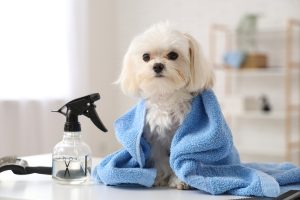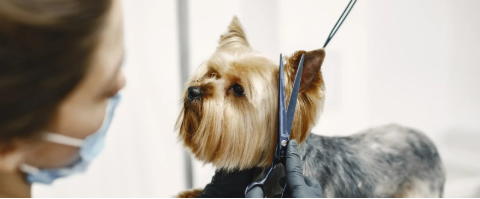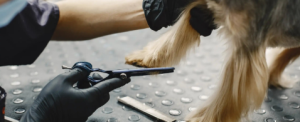Many pet parents ask why dogs fear grooming salons, especially when their dog trembles at the door, ears pinned back, and eyes filled with worry. Grooming is an important part of keeping pets healthy, maintaining clean coats, trimmed nails, and good skin condition. But for some dogs, the salon feels overwhelming, turning a necessary routine into a stressful event.
The good news is there are ways to help. Understanding the causes of this fear allows owners to take steps that reduce stress and make grooming more positive. Options like choosing a mobile dog grooming franchise can bring the experience directly to your home, offering a calmer and more personal solution.
This blog will explain the most common reasons behind grooming fear, highlight the signs of anxiety, and share practical strategies to support your pet. With the right approach, you can make grooming less intimidating and strengthen the bond you share with your dog.
Why Dogs Fear Grooming Salons
Why dogs fear grooming salons often comes down to a mix of environmental, emotional, and physical triggers. Understanding these factors is the first step toward easing your pet’s stress and making grooming a calmer experience for your dog.
1. Unfamiliar Environments
Salons can be sensory overload for dogs. The hum of clippers, the rush of dryers, and the strong scents of shampoos or cleaning products may overwhelm their sensitive senses. Even the presence of other anxious pets can add to the tension, as dogs quickly pick up on the stress around them.
2. Past Negative Experiences
A single unpleasant grooming experience can leave a lasting mark. Painful incidents like a nail clipped too short, rough handling, or razor burn from overheated clippers may cause dogs to associate grooming with discomfort. Rescue dogs, who may have histories of neglect or mistreatment, are often especially vulnerable to these associations.
3. Separation Anxiety
Some dogs struggle when apart from their owners, especially in unfamiliar spaces. At a grooming salon, this can look like whining, pacing, or even aggression. For dogs deeply bonded to their humans, being left with a dog groomer can feel like abandonment, heightening their distress.
4. Sensitivity to Handling
Many dogs dislike having their paws, ears, or tails touched, areas that dog groomers often handle. Breeds with sensitive skin or thick coats may also find brushing or clipping uncomfortable if not done properly. For example, a dog prone to ear infections might resist ear cleaning due to discomfort.
5. Sensory Overload
The combination of buzzing tools, barking dogs, strong chemical smells, and unfamiliar people creates an environment that can overwhelm even well-adjusted pets. Young dogs or those not used to busy surroundings may find this overstimulation especially challenging.
6. Fear of Restraint
Safety equipment like grooming nooses, harnesses, or muzzles is often necessary, but these restraints can make dogs feel trapped. A dog restrained on a grooming table may panic, leading to defensive behaviors such as struggling or snapping.
7. Lack of Familiarity
Dogs not introduced to mobile grooming early in life often find the experience intimidating. Puppies raised with regular brushing and nail trims adapt more easily, while adult dogs facing these routines for the first time may react with fear and uncertainty.
Strategies to Ease Grooming Anxiety
Helping your dog feel comfortable with grooming takes patience and consistency. By preparing at home and choosing the right support, like a mobile dog grooming service, you can make grooming a more positive routine.
1. Start Grooming Early
Introducing grooming services when dogs are young helps normalize the experience. Brushing their coat, gently handling paws, and trimming nails from puppyhood can reduce fear later in life. Some offer short introduction sessions so puppies can get used to the sights and sounds without stress.
2. Choose the Right Groomer
Finding a professional who understands how to calm nervous dogs grooming is key. Look for someone trained in gentle methods who focuses on your dog’s emotional well-being, not just the physical results. Mobile grooming services are also a good option since they bring care directly to your home in a calmer setting.
3. Desensitize at Home
You can prepare your dog by letting them explore the grooming equipment in a relaxed environment. Allow them to sniff brushes or clippers, then reward calm behavior. Gradually practice handling sensitive areas like paws and ears so the experience feels less strange when a groomer does it.
4. Use Positive Reinforcement
Rewarding your dog during grooming is one of the most effective ways to build trust. Offering treats, praise, or play during brushing or nail trims helps create positive associations. This simple step turns grooming from dread into an activity connected with rewards.
5. Create a Calm Environment
Keeping the space quiet and stress-free goes a long way. A calm voice, soft background music, and familiar scents can help. Many professionals rely on fear free grooming tips, such as giving breaks and introducing tools slowly, to make the process less intimidating.
6. Exercise Before Grooming
A walk or a game of fetch before an appointment can help your dog release nervous energy. This makes it easier for them to relax during grooming.
7. Take Breaks When Needed
If your dog starts showing stress signals like panting or whining, pause and let them reset. Even short breaks can help reduce overwhelm and make the process smoother.
8. Seek Professional Support
If anxiety remains severe, a veterinarian or certified trainer, perhaps one with experience in dog obedience training or service dog training, can provide guidance. Some dogs may benefit from extra behavior training to build confidence during handling. Professionals with the right training are also equipped to adapt their techniques for sensitive pets.
9. Keep Visits Short and Frequent
Instead of long, stressful sessions, shorter and more frequent appointments help dogs adjust. Quick visits for brushing or nail trims can slowly build familiarity and reduce fear over time.
Additional Considerations
1. Fear-Free Grooming
A growing number of groomers now use methods that focus on emotional well-being. These fear-free grooming tips include giving dogs freedom of movement, allowing breaks, and watching body language closely to prevent stress. Groomers trained in this approach can make a noticeable difference for anxious dog grooming.
2. Mobile Grooming Benefits
Mobile services create a quieter, more personal experience. By coming to your driveway, mobile groomers help reduce dog grooming anxiety caused by travel, crowded salons, or exposure to other animals. The one-on-one attention also builds trust over time.
3. The Owner’s Role
Dogs pick up on their owner’s energy. Staying calm and confident during drop-off, or while helping at home reassures your pet. Instead of over-comforting, which may increase worry, project positivity so your dog feels secure.
4. Special Cases
Some dogs have unique fears, such as claustrophobia or discomfort in tight spaces. In these cases, gradual exposure paired with rewards can help. Starting in open areas and slowly introducing smaller spaces creates a gentler adjustment.
When to Seek Professional Help
If your dog’s anxiety remains unmanageable despite home strategies, it may be time to seek professional support. A certified trainer with dog training program expertise can design a gentle desensitization plan, while a veterinarian can determine if additional interventions are necessary. In rare cases, medication may be recommended, but it should only ever be given under veterinary guidance.
For many pets, working with experienced groomers who specialize in sensitive dogs makes all the difference. These professionals know how to calm nervous dogs during grooming by using patience, breaks, and gentle handling. Partnering with the right groomer ensures your dog gets the care they need in a safe, compassionate environment.
FAQs
Why does my dog shake before grooming?
Shaking is a common sign of stress. Unfamiliar environments or past negative experiences can cause this. Try fear free grooming tips like gradual desensitization to help.
How can I prepare my dog for grooming?
Start by handling their paws and ears at home, using treats to reward calm behavior. Short, positive grooming sessions can reduce dog grooming anxiety.
Is mobile grooming better for anxious dogs?
Yes, mobile grooming reduces stress by keeping your dog in a familiar environment. Services like Kontota’s specialize in creating a calm, stress-free grooming experience for nervous dogs.
What if my dog is aggressive during grooming?
Aggression often stems from fear. Work with a groomer trained in fear free grooming tips and use positive reinforcement to build trust over time.
Conclusion
Grooming anxiety in dogs is common, but with patience and the right approach, it can be managed. By understanding the causes, whether it’s loud noises, unfamiliar places, or past experiences, you can take steps to ease your dog’s stress. Starting routines early, using positive reinforcement, and working with a skilled or mobile groomer can transform grooming into a calmer, more positive part of your pet’s life.
If you’re ready to give your dog a stress-free grooming experience, book a call with Kontota Franchising today and see how compassionate mobile grooming can make all the difference.





